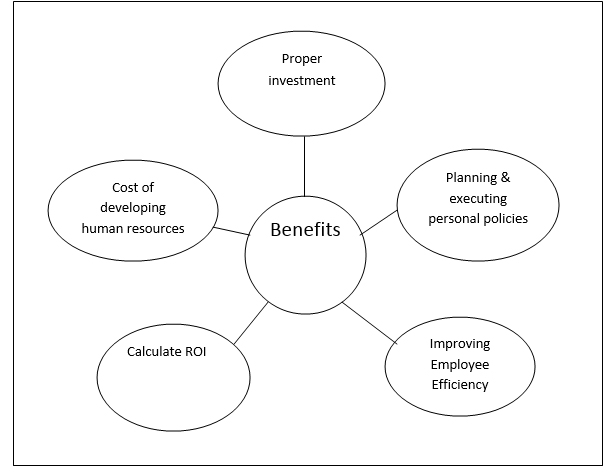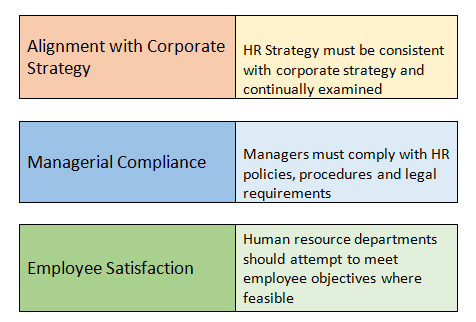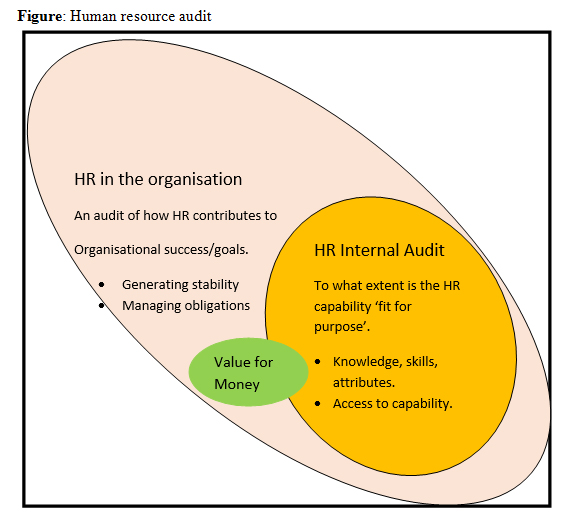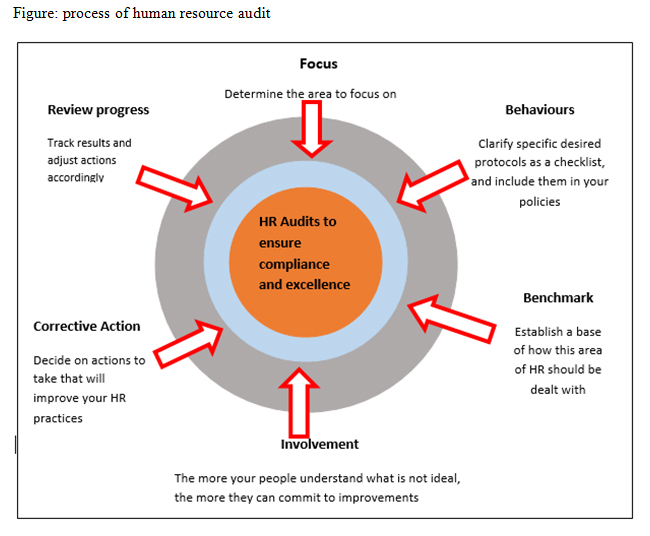Human resource accounting is the procedure to recognize and report the investments made in the Human Resources of an Organization that are currently not accounted for in the conventional accounting practices. It is an expansion of the Accounting Principles of matching the costs and revenues and of organizing data to converse significant information. Normally, human resource Accounting (HRA) engages accounting for the organization’s management and employees as human capital that provides future benefits. In the human resource accounting approach, expenditures associated with human resources are reported as assets on the balance sheet in contrast to the conventional accounting approach which treats costs related to a company’s human resources as expenses on the income statement that decrease profit.
Concept and historical review of Human Resource Accounting
In the decade of 1960, many researchers developed procedures of accounting for organizational human resource asset. It is based on the established notion that all expenditure of human capital formation is regarded as a charge against the revenue of the period as it does not create any physical asset. But this concept has changed and the cost incurred on any asset (as human resources) should be capitalized as it yields benefits quantifiable in financial terms. Human Resource Accounting indicates accounting for people as the organizational resources. It is the measurement of the cost and value of people to organization. It involves measuring costs incurred by private firms and public sectors to recruit, select, employ, train and develop employees and judge their economic value to the organization. Human resource accounting is a complicated way to determine in financial terms the effectiveness of the personal manager activities and the use of people in an organization. It is process of accounting people as an organization resource. It attempts to place a value on the organizational human resources as assets and not as expenses. This method demonstrates the investment made by organization in the people and how the value of these people changes over a time. The possession of employee is compared with the substitute cost from time to time.
According to American accounting association committee, Human Resource Accounting is the process of identifying and measuring data about human resource and identifying and measuring data about human resource and communicating this information to interested parties. Likert (1971) explained that Human Resource Accounting serves several purposes in an organization. It provides cost/value information for taking management decisions about acquiring, allocating, developing, and maintaining human resources in order to attain cost-effectiveness. It permits management employees to scrutinize effectively the use of human resources. Jasrotia (2004) emphasized the need for human resource accounting on India. The investigator concentrated on the remarkable shift from manufacturing to service rendering in the Indian economy where success of organizations depends on the knowledge and intellectual capabilities of personnel. The suggestion from the research was that Indian government should make the accounting and reporting of human resources mandatory for every organization just like as it is adopted in Denmark from the year 2015. HRA provides effective basis of human asset control, that is, whether the asset is appreciated, depleted or conserved. It assists in the development of management principles by classifying the financial consequences of various practices. Main goals of Human Resource Accounting is to provide cost value information about acquiring, developing, allocating and maintaining Reallocating and maintaining HR, enable management to effectively monitor the use of HR, enable management to effectively monitor the use of HR, find whether human asset is appreciating or depreciating, find whether human asset is appreciating or depreciating over a period of time, assist in the development of effective management practices, to motivate individual persons in the organization, increase their worth by training, in planning physical resource. The human resource accounting is done to provide cost value information for making appropriate and effective management decisions about acquiring, allocating, developing and maintaining human resources in order to achieve cost effective organizational objectives. Leading management scholar, Flamholtz (1979) explains the human resource accounting model as “psycho-technical systems” (PTS) approach to organizational measurement. This approach indicated that, the two functions of measurement are process functions in the process of measurement and numerical information from the numbers themselves. Therefore important role of human resource accounting is to present numerical measures. The HRA measurement process facilitates to increase recognition that human capital is vital to the organization’s short and long-term productivity and expansion.
Uses of Human Resource Accounting
Grojer and Johansson stated that human resource accounting is a political tool used to demonstrate mismanagement of human resource. It works as a pedagogical instrument for analyzing and structuring, and used as a decision making aid to ensure that decision on HR are more rational from the management point of view.
Benefits of Human Resource Accounting
There is several advantage of using human resource accounting. These include foresee the changes, provides different methods of testing , Increase productivity, brings high return, helps individual employee to aspire, provides scope for advancement, throws light on the strength and weaknesses of existing workforce and helps potential investors to judge a company.
Human Resources Accounting and Audit 
Limitations of Human Resource Accounting
Human resource accounting is not easy to value human asset. It results in dehumanizing human resource. There is no evidence. HR is full of measurement problem. Employees and Unions may not appreciate the ideas. This process is lack of Empirical evidence.
In India, companies do not give much consideration to issues related to human resource accounting. In India this concept is struggling for recognition and has not been initiated as a system. Indian companies act does not necessitate company to provide information related to workers cost in their annual report. Though, since last decade, there is awareness toward measurement and reporting of human asset. In India, Human resource accounting was first utilized in public sector by Bharat Heavy Electrical ltd (BHEL) in financial year 1972-73. Afterward, other organization both in public and private organization started to provide information related to human resource in the annual report. Organizations that are using human resource accounting process are Infosys, Steel authority of India, Southern Petrochemicals, Industries Corporation of India Ltd, Mineral and Metals Trading Corporation of India Hindustan Zinc Ltd, Associated cement Companies Ltd, Madras Refineries Ltd, Oil India ltd Oil and Natural Gas Commission and Cement Corporation of India.
To summarize, Human resource accounting evaluates the employees’ performance in terms of costs and contributions of employees. The fundamental reason for developing HR Accounting is to reduce problems arising from the valuation of intangible assets. HRA provides an insight on employees as assets and a profile to the enterprise and thus improves its status. HRA investigates to keep intelligent human capital. Human resource accounting considers human resources as equivalent to other assets in the organization. They need investment over time to make them productive. Such investment relates to the recruiting, exercise, and development costs, which are capitalized and amortized over an assumed probably productive life for the human resource, taking into account attrition and eventual deterioration, HR Accounting system attempts to evaluate the value of human resources of an organization in a systematic manner and record them in the financial statement to converse their worth with changes in time.
Human Resource Audit
Auditing has been a usual practice in the field of finance, particularly because it is a constitutional obligation. However, in case of Human Resource, there is no legal binding to implement auditing. Some of the companies favor the process of Human Resource audits. Human resource audit is a tool which appraises effectiveness of human resource functions of an organization.
Concept and scope of human resource audit:
The Human Resource Audit is an organized official process, which is designed to investigate the strategies, policies, procedures, documentation, structure, systems and practices with respect to the organization’s human resource management. It systematically and scientifically evaluates the strengths, constraints, and developmental needs of the existing human resources in order to improve organizational performance. The human resource audit is based on the principle that human resource processes are dynamic and must constantly be redirected and revived to remain responsive to the changing needs. Human Resource Audits are not regular practices aimed at problem solving. Instead of directly solving problems, HR audits, help in providing insights into probable causes for existing and future dilemmas.
Figure: Scope of human resource audit 
Human resource audit is conducted to ensure compliance, improve HR practices, train managers of company, prepare for potential government audit or litigation, gain an understanding of department’s environment, and show a “good faith effort and correct errors. Basic principles of audits are to identify the Scope, develop a Questionnaire, collect Data, benchmark Findings, provide Feedback about Results, create Action Plans and foster Climate of Continuous Improvement.
The main intent of audit in human resource is to clarify desired practices of HR work and roles within the organization (HR Department, Line Managers), to establish a baseline for future improvement, to evaluate current effectiveness, to standardize practices across multiple sites within a division or company, to assess current knowledge and skills required of HR practitioners and to improve performance levels to key customers within the organization.
There are two types of audit that include internal and external audit.
Internal audit: The internal audit is conducted by the company’s own staff as a part of their control activities.
External audit: The external audit is conducted by outsiders specifically employed for this purpose. The advantage is to get the employed for this purpose is unbiased evaluation by competent people of the manpower management function.

Preparation for an Audit
Auditor Engagement:If using internal resource, it is better to employ them formally with clarity on scope and select persons who are nonpolitical or those who are not high on hierarchy. Also, if internal persons are auditing there must be training in auditing.
Data gathering:Completion of a self-assessment questionnaire significantly expedites the audit process and allows for better audit planning.
On-site access: The on-site portion of the audit is the most important.
Human resource audit process: The human resource audit process is conducted in different phases. Each phase is designed to build upon the preceding phase so that the organisation will have a very strong impression of the HR function. The general process of conducting an audit includes seven key steps that are to determine the scope and type of audit, develop the audit questionnaire, collect the data, benchmark the findings, provide feedback about the results, create action plans and foster a climate of continuous improvement.
Scope and type of the audit: To reveal the needed information, it is vital to establish exactly what areas should be targeted for check. If the organization has never audited its human resource function, or if there have been current significant organizational or legal changes, the audit team can carry out a comprehensive review of all human resource practice areas. Alternatively, if concerns are limited to the sufficiency of a particular process or policy, the audit must concentrate a review of that particular area.
Develop the audit questionnaire: In next step, it is important to invest enough time in developing a comprehensive document that obtains information on all the subjects of the inquiry. A list of specific questions must be composed to ensure that the questionnaire is complete.
Collect the data: The next stage includes the actual process of assessing specific areas to collect the data about the company and its human resource practices. Audit team members will use the audit questionnaire as tool to review the specific areas identified within the range of the audit.
Benchmark the findings: To completely review the audit findings, auditors must be compared with human resource benchmarks. This comparison will offer insight into how the audit results compare against other similar size of firms. Typical information that might be internally benchmarked includes the company’s ratio of total employees to HR professionals, general and administrative costs, cost per new employees hired, etc. Benchmarking might include the number of days to fill a position, average cost of annual employee benefits, absenteeism rates.
Provide feedback about the results: In this step of the audit process, the audit team must review the data and give feedback to the company’s human resource experts and senior management team in the form of findings and recommendations. Findings normally are reduced to a written report with recommendations prioritised based on the risk level assigned to each item. From this final analysis, framework for action can be developed that will help determine the order in which to address the issues raised. In addition to a formal report, it is significantly important to examine the results of the audit with employees in the human resource department, as well as the senior management team, so everyone is conscious of needed changes and approvals can be obtained promptly.
Create action plans: In this step, it is crucial actually to analyse the information identified as a result of an audit. The company must generate action plans for implementing the changes proposed by the audit, with the findings separated by order of importance: high, medium and low. It really increases legal risk to conduct an audit and then fail to act on the results.
Foster a climate of continuous improvement: At the end of the audit, it is essential to constantly observe and improve the company’s policies, procedures and practices so that the organization never stop to keep improving. This will make certain that the company achieves and retains its competitive advantage. In the process of continuously monitoring human resource systems, it is to ensure that they are updated with latest information and to have follow-up mechanisms built into every one of them. Similarly, it is important to keep track of the audit findings/changes made, turnover, complaints filed, hotline issues, employee survey results to recognize trends in the company’s employment-related issues. Identifying problematic issues, growth areas or declining problem spots can assist in the decision of where to allocate time, money and take preventive measures.

Approaches to Human Resource Audit
There are five approaches for the purpose of evaluation of HR in any organization. These include Comparative approach, Outside authority, Statistical, Compliance approach and Management By Objectives (MBO).
main steps of the audit is to Define desired HR practices for your organization, Assess current practices against the criterion that you have established, Analyze the results, and establish improvement goals and take action.
Comparative approach: In this approach, the auditors identify Competitor Company as the model. The results of their organization are compared with that Company/ industry.
Outside authority approach: The auditors use standards set by an outside consultant as benchmark for comparison of own results.
Statistical approach: Statistical measures of performance is developed considering the company’s existing information.
Compliance approach: Auditors review past actions to calculate whether those activities comply with legal requirements and industry policies and procedures.
Management by objectives (MBO) approach: This approach creates specific goals, against which performance can be measured, to arrive at final decision about organization’s actual performance with the set objectives.
Benefits of Human Resource Audit
Human resource audit has many advantages. Human resource audit helps to find out the proper contribution of the HR department towards the organization. It enhances the professional image of the HR department of the organization, reduce the HR cost, motivate the HR personnel, find out the problems and solve them smoothly, provides timely legal requirement. Human resource audit has effective Performance Appraisal Systems and Systematic job analysis. It has smooth adoption of the changing business attitude.
To summarize, Human resource audit denotes people and the processes that are responsible for efficient working in organizational functions. Human resource audit can qualify its effectiveness within an organization. Human Resource audits may achieve many objectives, such as ensuring legal compliance; helping maintain or improve a competitive advantage; establishing efficient documentation and technology practices; and identifying strengths and weaknesses in training, communications and other employment practices. Human Resource auditing is something that many companies do yearly, just as they audit their financial information. This gives them an accounting of their personnel and the efficiency with which the organization as an entity deals with its people, from recruiting to firing. Human resource audit helps senior management to guarantee compliance with wage-and-hour laws and the myriad of other employment and benefits-related statutes. It examines the effectiveness and costs of HR policies and practices and their role in the organizations strategic planning and benchmark actual against desired performance and develops an action plan for addressing shortfalls. HR audit saves money by identifying and correcting inefficiencies and compliance problems. This process allows a company to get a general thought of where it stands so that it can rectify any potential problems and plan for the future. Human Resource Accounting benefits the company to determine how much investment it has made on its employees and how much return it can anticipate from this asset.


 Users Today : 649
Users Today : 649 Total views : 467700
Total views : 467700